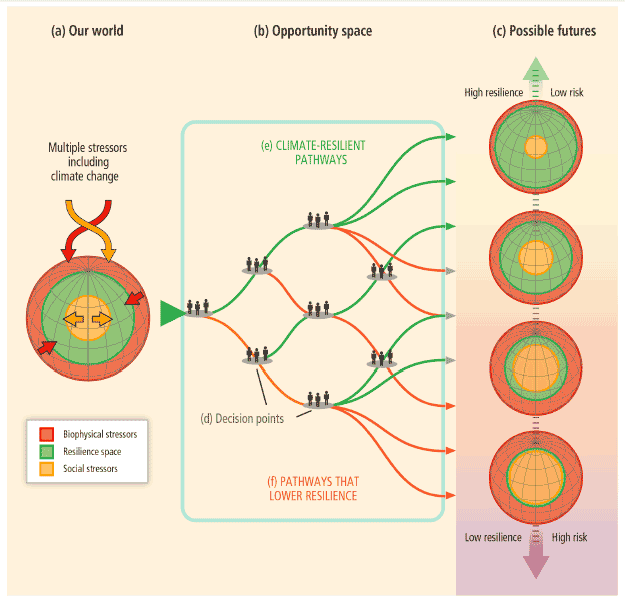The United Nation's Intergovernmental Panel on Climate Change (IPCC) has released another piece of its fifth report on global warming, its first since 2007.
Part 1 was released in late 2013, and focused really on the scientific evidence of global warming occurring (which it said was incontrovertible) and man-made greenhouse gases being responsible for most of it (highly likely). See IPCC Report Released, Generates Strident Commentary on Both Sides of the Debate.
Last week, another report was released that looked at the expected impacts on a variety of measures and quality of life issues. The full document is thousands of pages long, and the "Summary for Policy Makers" alone comes in at 44 pages, and as usual it is almost unreadable from a structure and language perspective.
Nevertheless, The GreenSupplyChain.com has waded through the full summary document, and we will do our best to summarize key details.
There are three noteworthy aspects up front:
(1) This report very specifically is pushing a "risk management" approach to dealing with global warming, as we will review below
(2) It notes up front that this report is able to tap into a significantly broader set of research on the potential impact of global warming, saying such output by academics and others doubled between 2005 and 2010.
(3) It is marked by some admission of uncertaintly, specifically recognizing how difficult it is to predict precisely how the planet will respond to rising CO2 and rising temperatures.
This last one is no doubt in part also because the 2007 report made some very bad predictions, such as that Himalayan glaciers would melt by 2035, whereas in fact they have instead been growing of late. This year the IPCC is much more conservative about what can and cannot be known about a changing climate.
Nevertheless, the report predicts with high confidence that:
• the negative impacts of warming on crop yields will outweigh any potential positive impacts
• median farm yields will decline by up to 2% per decade for the rest of the century, against a backdrop of rising demand that is set to increase by 14% per decade until 2050
• that violent conflict will exacerbate the effects of global warming
• that glaciers will continue to shrink as the climate warms, which has major impacts for downstream water supplies
• that species on land and in the sea are shifting their range in response to warming and that some will face an increased risk of extinction
• that health impacts will be felt from heat waves and from floods in low-lying areas
• that the seas will continue to acidify, destroying coral reefs
It also notes that "Impacts from recent climate-related extremes, such as heat waves, droughts, floods, cyclones, and wildfiresreveal significant vulnerability and exposure of some ecosystems and many human systems to current climate variability (very high confidence)."
But as noted, the IPCC is at times very uncertain in just how bad many of these effects will be. For example, it estimates the range of likely reduction in global economic output from a global mean temperature increase of 2.5 degrees Celsius above pre-industrial levels at coming in somewhere between .2% and 2% - a very broad range.
2% would indeed have quite an impact, lowering global GDP by trillions of dollars. The .2% level, however, would have negligible impact and really be hard to measure.
Focus on Risk Management
As part of its overall focus on risk management, the report interestingly devotes quite a few pages to various aspects of "adaptation" to warming temperatures. We take this to mean that in addition to taking steps to try to reduce rising temperatures by reducing CO2 emissions, countries also need to do more to plan how to mitigate the impact of warming on various ecosystems.
For example, the report notes that In Europe, adaptation policy has been developed across all levels of government, with some adaptation planning integrated into coastal and water management, into environmental protection and land planning, and into disaster risk management.
Australia is developing broad plans for a rise in sea levels, and in the Southern part of the country, planning efforts for reduced water availability are becoming adopted widely.
But, the report notes, "Responding to climate-related risks involves decision-making in a changing world, with continuing uncertainty about the severity and timing of climate-change impacts and with limits to the effectiveness of adaptation."
These uncertainties call for a more specific and formal approach to risk management, the report says. So, the IPCC assesses the level of risk across a number of different areas and with recognition of a range of warming levels. Risks at a 1-2 degree level are not nearly as significant as those that would be present for a 4-degree rise, for example.
And risks of course vary by geography and more. The report says that "Adaptation is place and context specific, with no single approach for reducing risks appropriate across all settings."
The bottom line, the report says, is that over time there will be a series of decisions that will take the world down a series of "pathways" that it says will ultimately lead to different scenarios: high resiliency and less environmental stresses, low resiliency and high stress, and scenarios in between, as shown in the graphic below.
IPCC's Says a Series of Decision will Create Differnt "Pathways" for the Future

Source: IPCC
TheGreenSupplyChain.com believes the effectiveness of these IPCC reports would be much enhanced by an improvement in the writing style, but with participation from hundreds of scientists from across the globe, maybe this is the best that can be achieved.
What is your reaction to this new IPCC report? Let us know your thoughts at the Feedback button below.

|